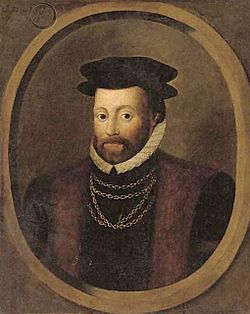Edward North, 1st Baron North facts for kids
Quick facts for kids
Edward North
|
|
|---|---|

Lord North.
|
|
| Clerk of the Parliaments | |
| In office 1531–1540 |
|
| Monarch | Henry VIII |
| Preceded by | Brian Tuke |
| Succeeded by | Thomas Soulemont |
| Sheriff of Cambridgeshire and Huntingdonshire | |
| In office 1542–1543 |
|
| Monarch | Henry VIII |
| Preceded by | Oliver Leder |
| Succeeded by | Robert Ap Rice |
| Lord Lieutenant of Cambridgeshire | |
| In office 1557–1564 |
|
| Monarch | Mary I, Elizabeth I |
| Preceded by | William Parr |
| Succeeded by | Roger North |
| Personal details | |
| Born | c. 1504 London |
| Died | 31 December 1564 (aged 59–60) Charterhouse, London |
| Resting place | Kirtling, Cambridgeshire 52°11′21″N 0°27′54″E / 52.1891°N 0.4650°E |
| Spouses | Alice Squire Margaret Butler |
| Children | Roger Thomas Christiana Mary |
Edward North, born around 1504, was an important English politician and nobleman. He served as the Clerk of the Parliaments from 1531 to 1540. He was also the Lord Lieutenant of Cambridgeshire from 1557 to 1564. Edward North was a very successful lawyer. He became the first Baron North, which gave him a special seat in the House of Lords.
Contents
Early Life and Family
Edward North was born in London around 1504. He was the only son of Roger North, a merchant from Nottinghamshire. His mother was Christiana. After his father passed away in 1509, his mother married Sir Ralph Warren. Sir Ralph later became the Lord Mayor of London.
Edward had a sister named Joan. She married William Wilkinson, who was also a merchant in London. Joan later worked for Queen Anne Boleyn.
A Busy Career in Government
Edward North went to St Paul's School and then to Peterhouse, Cambridge. He later became a lawyer. He worked for the City of London, likely with help from his sister's husband.
In 1531, Edward became the Clerk of the Parliament. This was an important job helping with government records. In 1541, he became the treasurer of the Court of Augmentations. This court managed lands that the king had taken from monasteries.
Edward North was knighted in 1541. He also served as the High Sheriff of Cambridgeshire in 1543. He was elected to represent Cambridgeshire in Parliament several times.
He became a member of the Privy Council of England in 1546. This was a group of trusted advisors to the king. King Henry VIII trusted Edward North. He even named him as one of the people to carry out his will.
When King Edward VI became king, Edward North continued to serve on the Privy Council. He was involved in important decisions.
Serving Under Different Monarchs
Edward North was pardoned by Queen Mary I. He was again sworn into the Privy Council. In 1554, he was given the title Lord North of Kirtling. This meant he became a baron and could sit in Parliament.
He was present at important events. These included receiving Philip II of Spain and Queen Mary's wedding.
When Queen Elizabeth I became queen, she stayed at Lord North's home in London. He was later appointed Lord-Lieutenant of Cambridgeshire. This role meant he was the queen's representative in the county.
Lord North often entertained the Queen at his home. He died in London in 1564. He was buried at Kirtling, next to his first wife.
Marriages and Children
Lord North was married twice. Around 1528, he married Alice Squier. Alice was a wealthy widow. Her money helped Edward buy the Kirtling estate. This estate stayed in his family for a long time.
Edward and Alice had two sons:
- Roger North, 2nd Baron North
- Sir Thomas North, who was famous for translating a book called 'Plutarch's Lives'.
They also had two daughters:
- Christiana, who married William Somerset, the Earl of Worcester.
- Mary, who married Henry Scrope, the Baron Scrope of Bolton.
His second wife was Margaret Butler. She was also a wealthy widow. She brought him a lot of money, which he left to her when he died.
![]() This article incorporates text from a publication now in the public domain: Jessopp, Augustus (1895). "North, Edward". Dictionary of National Biography 41. Ed. Sidney Lee. London: Smith, Elder & Co. 154-155.
This article incorporates text from a publication now in the public domain: Jessopp, Augustus (1895). "North, Edward". Dictionary of National Biography 41. Ed. Sidney Lee. London: Smith, Elder & Co. 154-155.

